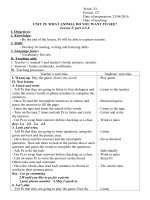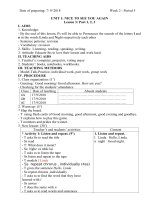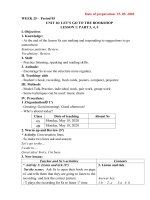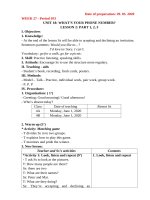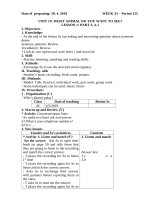giao an tieng anh lop 4 tuan 610
Bạn đang xem bản rút gọn của tài liệu. Xem và tải ngay bản đầy đủ của tài liệu tại đây (163.17 KB, 26 trang )
Week 6:
Monday, October 2st , 2018
Period 21 :
Review
----------------------------------------------------------------------------------------------------
Unit 2: I like monkey !
Lesson One – Period 22
I/ Aims:
- Identifying and describing zoo animals
II/ Language contents:
1.Structure: I like…; I don't like…;
2.Vocabulary: Zoo animals: elephant, giraffe, monkey; Descriptive adjectives:
big, tall, little
III/ Teaching Aids: The zoo flashcards 11-16; Story Poster 2; CD tracks 14-16;
IV/ Steps of teaching:
1.Warm up and reviews:
- Sing It’s a square! (p.10) to warm the class up.
2. Presentation:
-Talk about zoos with children. Ask Do you like zoos? What animals can you see
at the zoo? Use flashcards 11-13 to elicit the zoo animals for this lesson. Hold
them up one at a time and ask What's this? Model any words that children do not
know. Use flashcards 14-16 to elicit the adjectives. Hold them up one at a time for
children to say the words.
3. Practice:
Listen , point and repeat.
- Ask children to look at the flashcards of the different animals and the adjectives.
Play the 1st part of the recording for children to listen and point to the appropriate
card. Play the 2nd part of the recording for children to repeat. Play the recording all
the way through again for children to listen and point and then repeat the words in
chorus.
Listen and chant.
- Play the recording for children to listen to the chant. Play the chant a second time
for children to say the words.
4. Production:
- Play What am I? Ask children to work in groups of 4 -6. Each child chooses the
zoo animal they like and doesn’t tell it to other group members. He/ She describes
it by miming and says I am big. Other children in group guess. It’s an elephant.
Then it’s the turn of the child who guesses correctly. The game continues to the
last child.
V/ Extension: ........................................................................................................
-------------------------------------------------------------------------------------------------
Thursday, October 4 th , 2018
Unit 2: ( cont )
Lesson One – Period 23
I/ Aims:
- Identifying and describing zoo animals
II/ Language contents:
1.Structure: I like…; I don't like…;
2.Vocabulary: Zoo animals: elephant, giraffe, monkey; Descriptive adjectives:
big, tall, little
III/ Teaching Aids: The zoo flashcards 11-16; Story Poster 2; CD tracks 14-16;
IV/ Steps of teaching:
1.Warm up and reviews:
- Put the animal flashcards (11-13) on the board, one below the other. Give the
adjective flashcards (14-16) to three children. Ask the children to come to the front
of the class one at a time, and put the flashcard next to the animal it describes in
the story. Take the animal flashcards from the board and give them to three
different children. Shuffle the adjective flashcards and put them back on the board.
Ask children to come to the front and put the animals next to the adjectives that
describe them.
2. Presentation:
Listen and read
- Use Story poster 2 to present the story. Ask Who can you see? Where are they?
What's happening? Encourage predictions from different members of the class.
Ask children to look at the poster, listen to the recording, point to each speech
bubble. Ask Where is Rosy and her family? Does Billy like elephants / giraffes /
monkeys? Why?/ Why not? Ask children to open their Class Books, listen again
and follow the words in the story.
3. Practice:
- Ask children to work in pairs, read and draw two routes to the ice cream shop,
choose their own route and then talk to their partner.
- Remind children of What are these? They are…. Ask children to work in pairs.
Children look at the pictures and the words in Exercise 1, identify and describe the
zoo animals. They then write the answers.
2. monkeys. They’re little. 3. elephants. They’re big.
4. Production:
- Play What am I? Ask children to work in groups of 4 -6. Each child chooses the
zoo animal they like and doesn’t tell it to other group members. He/ She describes
it by miming and says I am big. Other children in group guess. It’s an elephant.
Then it’s the turn of the child who guesses correctly. The game continues to the
last child.
V/ Extension: ........................................................................................................
-------------------------------------------------------------------------------------------------
Unit 2: ( cont )
Lesson Two – Period 24
I/ Aims:
- Talking about likes and dislikes
II/ Language contents:
1.Structure: I like, I don’t like…
2.Vocabulary: Zoo animals: elephant, giraffe, monkey. Descriptive adjectives:
big, tall, little
III/ Teaching Aids: Story Poster 2; Zoo flashcards 11-16; CD track 16
IV/ Steps of teaching:
1.Warm up and review:
- Play What's missing? with the flashcards (see page 20) to revise the vocabulary
from the previous lesson.
2. Presentation:
Listen to the story again and repeat.Act
- Point to Story poster 2 and ask children what happened in the story. Cover the
poster and ask children which animals appeared in the story.
- Ask children to open their books and check. Play the recording, pausing for
children to repeat. Ask children to work in groups of 7 and practise acting out the
story. Ask some of the groups to act before the class.
Look and say
- Elicit the pattern, e.g. I like giraffes. I don't like monkeys. They're little. I'm tall.
Read them out loud for the class to repeat.
Explain children what form be is for I, We or They. Write I am, We are, They are
on the board. Note children of the short forms You're and They're
3. Practice:
- Ask children to read the likes or dislikes of the people in the pictures. They then
color the appropriate faces. Children then work in pairs and compare the answers
with their partner.
1. Smiley. 2. Sad face. 3. Sad face. 4. Smiley. 5. Smiley. 6. Sad face.
- Ask children to look at the pictures and the faces. Write sentences with like or
don’t like. Children can compare the answers with a partner.
1. don’t like giraffes. 2. like monkeys. 3. I like zebras. 4. I don’t like elephants.
4. Production:
- Game: Ask children to work in groups of 4- 6. Each child draws an animal for
their friends to say like or dislike. He then draws a smiley or a sad face and writes
their friends’ names next to the animal. Children take turns to do the same.
Encourage children to draw different animals.
Ask some of the groups to report their friends’ likes or dislikes before the class.
V/ Extension: ........................................................................................................
Week 7
Monday, October 8th , 2018
Lesson Two – Period 25
I/ Aims:
- Talking about likes and dislikes
II/ Language contents:
1.Structure: I like, I don’t like…
2.Vocabulary: Zoo animals: elephant, giraffe, monkey. Descriptive adjectives:
big, tall, little
III/ Teaching Aids: Story Poster 2; Zoo flashcards 11-16; CD track 16
IV/ Steps of teaching:
1.Warm up and review:
- Call out the names of animals from Exercise 4 for individual children to describe,
e.g. Teacher: Zebras. / Child: They're black and white. Write two sentences on the
board and elicit so that children can recall a smiley (like) or a sad face (don’t like)
2. Presentation:
Write:
- Write some gapped sentences on the board, using animal words, e.g. I …chicks /
dogs. Next to each sentence, draw a smiley (like) or a sad face (don’t like).
Complete the sentences with like or don't like. Children finish exercise 3.
1 I like lions. 2 I don't like elephants. 3 I don't like giraffes. 4 I like monkeys
3. Practice:
Say and answer.
- Ask children to look at the pictures. Point to the different animals for children to
name them. Model the dialogue. Ask children to work in pairs. They take turns to
describe the animals for their partner to guess. Ask some of the children to describe
an animal for the class to guess .
- Ask children to work in pairs. They take turns to say whether or not they like the
animals. If possible, they should give reasons.
E.g. I don't like lions. They're big.
4. Production:
- Game: Ask children to work in groups of 4- 6. Each child draws an animal for
their friends to say like or dislike. He then draws a smiley or a sad face and writes
their friends’ names next to the animal. Children take turns to do the same.
Encourage children to draw different animals.
Ask some of the groups to report their friends’ likes or dislikes before the class.
V/ Extension: ........................................................................................................
-------------------------------------------------------------------------------------------------Lesson Three – Period 26
I/ Aims:
- Identifying and describing zoo animals.
II/ Language contents:
1.Structure: Let’s go…
2.Vocabulary: Zoo animals: tiger, snake, parrot. hip, hooray!, growl, hiss,
squawk, hear
III/ Teaching Aids: CD tracks 17- 18, Zoo flashcards 11-19
IV/ Steps of teaching:
1.Warm up and reviews:
- Revise the vocabulary from the previous lesson. Describe animals for the class to
guess, e.g. It's big. It's grey. What is it? It's an elephant.
2. Presentation:
- Use flashcards 17-19 to introduce the three new words. Hold up the cards one at a
time and say the words for children to repeat. Put the flashcards on the board and
point to them in a different order for children to repeat again.
3. Practice:
Listen, point and repeat.
- Ask children to look at the pictures and play the first and second parts of the
recording as children point to the words. Play again for children to repeat the
words after the audio.
4. Production:
- Game: Play a game with children using animal sounds. Ask children to make the
sounds for the parrot, snake, and tiger from the song. Then ask them what sounds
elephants, monkeys, cats, dogs, and birds make. Call out the name of one of these
animals. All the children have to make the sound of that animal. Choose different
children each time to call out the name of an animal for the rest of the class to
make their sound.
V/ Extension: ........................................................................................................
--------------------------------------------------------------------------------------------------
Thursday, October 11 st , 2018
Unit 2: ( cont )
Lesson Three – Period 27
I/ Aims:
- Identifying and describing zoo animals, Listening and speaking skills
II/ Language contents:
1.Structure: Let’s go…
2.Vocabulary: Zoo animals: tiger, snake, parrot. hip, hooray!, growl, hiss,
squawk, hear
III/ Teaching Aids: CD tracks 17- 18, Zoo flashcards 11-19
IV/ Steps of teaching:
1.Warm up and reviews:
- Use flashcards 11-19 to review zoo animal words. Hold up the cards one at a time
and ask children to say the words. Put the flashcards on the board and point to
them in a different order for children to say the words again.
2. Presentation:
Listen and sing.
-Use the song worksheet (without opening the Class Book) where children listen
and fill in the correct words. After that ask children to sing along with the CD and
then sing together without the CD audio.
3. Practice:
Sing and do.
- Ask children to look at the pictures and decide together on what the actions
should be (see suggestions below). Practise the actions with the class. Play the
recording for children to listen and do their actions.
Song actions
tiger - hold fingers up like claws
snake - wiggle one arm like a snake
parrot - flap arms like wings
4. Production:
- Game: Play a game with children using animal sounds. Ask children to make the
sounds for the parrot, snake, and tiger from the song. Then ask them what sounds
elephants, monkeys, cats, dogs, and birds make. Call out the name of one of these
animals. All the children have to make the sound of that animal. Choose different
children each time to call out the name of an animal for the rest of the class to
make their sound.
V/ Extension: ........................................................................................................
---------------------------------------------------------------------------------------------------Lesson Four – Period 28
I/ Aims:
- Phonics - CVC words /a/, Speaking and writing skills
II/ Language contents:
1.Structure:
2.Vocabulary: Cat, man, fan
III/ Teaching Aids: CD tracks 19 -20, Phonics cards 4 - 6
IV/ Steps of teaching:
1.Warm up and review:
- Remind children of th and /θ/ . Play the CD and say the chant from page 11 to
revise the sound /θ /.
2. Presentation:
Listen, point and repeat
- Hold up the cat, fan, and man phonics cards one at a time, saying the words for
the class to repeat. Ask children what today's letter is (a) and what sound it makes
(/æ/). Use the flash cards in order and then out of order to drill the sound.
- Play the first part of the recording for children to listen and point to the pictures.
Play the second part of the recording for children to repeat the sounds and words in
chorus. Play the recording all the way through for children to point to the words
and then repeat them
3. Practice:
Listen and chant
- Children join in with the chant. Put the three cards around the room and children
point as they say the chant.
4. Production:
Phonics game: Ask children to work in groups of two desks. Ask each group to
find more words which is pronounced the same as man and make sentences with
the words. E.g. The cat has got a hat. Encourage children to make the words into a
chant. Ask the class to decide on actions for the chant and then to recite the chant
again as they do their actions. Ask them to act before the class.
V/ Extension: ........................................................................................................
---------------------------------------------------------------------Week 8
Monday, October 15th , 2018
Unit 2: ( cont )
Lesson Four – Period 29
I/ Aims:
- Phonics - CVC words /a/, Speaking and writing skills
II/ Language contents:
1.Structure:
2.Vocabulary: Cat, man, fan
III/ Teaching Aids: CD tracks 19 -20, Phonics cards 4 - 6
IV/ Steps of teaching:
1.Warm up and review:
- Hold up the flashcards one at a time for individual children to sound out the
letters and say the words (cat, man, fan). Ask individual children to come to the
front and write the letters on the board.
2. Presentation:
Read the chant again.Circle the a in the middle of the words.
-Ask children to look at the chant again. Focus attention on the circled a in the
middle of cat. Ask children to find and circle other examples of a in the middle of
words. Go through the exercise with the class.
Write.
- Ask children to look at the pictures. Point to each one for children to say the
word. Write t h a on the board. Ask a child to come before the class and write the
correct word (hat). Children complete the questions individually. Go through the
answers with the class. 1 hat 2 man 3 fan 4 cat
3. Practice:
- Write the words from Exercise 4 on the board (hat, man, fan, cat). Ask children
to work in groups in 3 minutes and find more words with a (/æ/). The group who
can find more words win the game.
- Children do the exercise and write the sentences to describe the pictures.
Children can compare their work in pairs.
1. The cat has got a hat. 2. The man has got a fan.
4. Production:
Phonics game: Ask children to work in groups of two desks. Ask each group to
find more words which is pronounced the same as man and make sentences with
the words. E.g. The cat has got a hat. Encourage children to make the words into a
chant. Ask the class to decide on actions for the chant and then to recite the chant
again as they do their actions. Ask them to act before the class.
V/ Extension: ........................................................................................................
Lesson Five – Period 30
I/ Aims:
- Identifying and describing zoo animals, Reading skills
II/ Language contents:
1.Structure:
2.Vocabulary: leaves, guess, top, tongue, wrong, there, food, head, neck, at all,
listen, true, on top of
III/ Teaching Aids: CD tracks 21
IV/ Steps of teaching:
1.Warm up and reviews:
- Play a game of Mime the word (see page 20) with animal words to energize the
class and revise vocabulary from the unit.
2. Presentation:
- Ask children to look at the picture and tell you what they can see (a giraffe). Ask
What’s the giraffe doing? (It's eating leaves from a tree). Ask children to try to
predict what the text is about (It’s a poem about the giraffe).
Look at the picture. Talk about the animal.
- Ask children to look at the picture again. Ask them to tell you everything they
can about the giraffe in English, e.g. It’s a giraffe. It’s tall. It’s brown and yellow.
It's got four legs.
3. Practice:
Read and listen to the poem.
- Play the recording for children to listen to the poem. Play the recording a second
time while children read the poem in their books. Check comprehension by asking
Where is the giraffe? What does it look like? What can it see? What does it eat?
How does it get its food? What does it say?
Read again. Write T ( true ) or F ( false ).
- Write The giraffe is tall. on the board. Elicit to establish that the sentence is true.
Point out the example sentence in the Class Book. Ask children to read the other
sentences and then read the poem again to see whether the sentences are true or
false. Play the recording again as they mark their answers. Go though the answers
with the class. 1 T 2 F 3 F 4 T
4. Production:
Game: Put the cut-up pictures of animals on the table in front of you. Pick some of
them up and show them to the class. Ask What’s the animal? What can you see an arm or a leg? Children work in groups of 4- 6, get different parts of the animals
(legs, heads, bodies, and tails), a large piece of paper and a glue stick. They stick
the body parts in the correct positions so that the animal is complete. They then
write the animal's name next to the image on the paper. Children take turns to
pretend to be the animal and say something about themselves (The giraffe poem as
a model), e.g. I am a ... I've got … ears.
V/ Extension: ......................................................................................................
-------------------------------------------------------------------------------------------------
Thursday, October 18th , 2018
Unit 2: ( cont )
Lesson Five – Period 31
I/ Aims:
- Identifying and describing zoo animals , Reading and writing skills
II/ Language contents:
1.Structure:
2.Vocabulary: leaves, guess, top, tongue, wrong, there, food, head, neck, at all,
listen, true, on top of
III/ Teaching Aids: CD tracks 21
IV/ Steps of teaching:
1.Warm up and reviews:
- Ask children to look at the picture and say what they see (boys, girls, parents,
monkeys, snakes…). Tell children that they are going to read another poem.
2. Presentation:
- Children read the poem and tick the animals in the poem. Go through the answers
with the class. 1 parrots ,2 monkeys ,4 zebras ,6 snakes
- Children read the poem again and write T/ F for each sentence. Ask them to work
in pairs and check the answers. 1T, 2F, 3T, 4T, 5F, 6T
3. Practice:
- Animal mask: Ask children to color the animal mask and then cut it out. Children
then cut out the holes for the eyes carefully; make small holes on the sides of the
mask. Show children how to thread string through the holes. Ask children to put on
the masks and sing Let’s go to the zoo!
- Crossword pair activity: Ask children to work in pairs. Try to work out all the
animal words and then write the words.
4. Production:
Game: Put the cut-up pictures of animals on the table in front of you. Pick some of
them up and show them to the class. Ask What’s the animal? What can you see an arm or a leg? Children work in groups of 4- 6, get different parts of the animals
(legs, heads, bodies, and tails), a large piece of paper and a glue stick. They stick
the body parts in the correct positions so that the animal is complete. They then
write the animal's name next to the image on the paper. Children take turns to
pretend to be the animal and say something about themselves (The giraffe poem as
a model), e.g. I am a ... I've got … ears.
V/ Extension: ......................................................................................................
------------------------------------------------------------------------------------------------
Lesson Six – Period 32
I/ Aims:
- Identifying and describing zoo animals, Listening and speaking skills
1.Structure:
2.Vocabulary: Pretty, next, first
III/ Teaching Aids: CD tracks 22
IV/ Steps of teaching:
1.Warm up and reviews:
- Play What's the picture? (see page 21) using the animal words from the unit.
2. Presentation:
- Put flashcards 11-19 on the board, with the animals on one side and the adjectives
on the other side. Point to an animal. Ask different children What's this? Do you
like lions /tigers / snakes? Encourage children to give reasons why they do or don't
like the animal. They should use the adjectives on the board to help them.
Listen and draw or .
- Tell the class that they are going to hear children talking about the animals in the
pictures. Children must listen and draw a smiley face if the child on the recording
likes the animal and a sad face if he / she doesn't. Check together. 1 2 3 4
5 6
3 .Practice:
- Model the dialogue. Ask a pair of children to read the dialogue. Ask children to
work in pairs, take turns to describe the animals in the box for their partner to
guess. Ask one child to describe an animal for the class to guess.
4. Production:
Sentence making: Write a list of adjectives on the board, one below the other, e.g.
tall, little, big, yellow, nice, black, white. Point to each adjective in turn and ask the
class which animal they think it could describe. Write the name of the animal after
the appropriate adjective. As a class, extend the animal descriptions to make
complete sentences, e.g. This is a tall giraffe.
V/ Extension: ........................................................................................................
----------------------------------------------------------------------------------------------------
Week 9
Monday, October 22nd , 2018
Lesson Six – Period 33
I/ Aims:
- Identifying and describing zoo animals, Listening and speaking skills
1.Structure:
2.Vocabulary: Pretty, next, first
III/ Teaching Aids: CD tracks 22
IV/ Steps of teaching:
1.Warm up and reviews:
- Ask children to work in pairs. They imagine they are at the zoo. They take turns
to talk about the zoo animals, saying whether or not they like them. Encourage
children to state a reason.
2. Presentation:
- Identify the adjective by asking Where's the adjective? Circle the adjectives in the
two sentences. Ask children to look at the exercise in their Class Books and circle
the adjective in each of the sentences. Check together.
1 yellow, 2 green, 3 brown, 4tall, 5 orange/ black, 6 blue
3. Practice:
- Write a list of adjectives on the board, one below the other, e.g. tall, little, big,
yellow, nice, black, white. Give example and elicit the pattern. E.g. This is a tall
giraffe
- Children read the sentences and add an adjective to each sentence. They then
work in pairs to compare the answers.
2. This is a big dog. 3. This is a long snake. 4. He’s got short hair. 5. It’s got little
ears. 6. It’s a brown monkey.
- Children think about the animals they like/ dislike. They then circle the animals
they like and underline the animals they don’t like. Ask children to work in pairs,
talk about their likes/ dislikes.
4. Production:
Sentence making: Write a list of adjectives on the board, one below the other, e.g.
tall, little, big, yellow, nice, black, white. Point to each adjective in turn and ask the
class which animal they think it could describe. Write the name of the animal after
the appropriate adjective. As a class, extend the animal descriptions to make
complete sentences, e.g. This is a tall giraffe.
V/ Extension: ........................................................................................................
---------------------------------------------------------------------------------------------------Period 34 :
Thursday, October 25th , 2018
Unit 3: Dinnertime !
Review
Lesson One – Period 35
I/ Aims:
- Identifying foods and asking about likes and dislikes
II/ Language contents:
1.Structure: Yes, I do. No, I don’t.
2.Vocabulary: Foods and drinks: rice, meat, carrots, yogurt, fish, bread
III/ Teaching Aids: CD tracks 23- 25, My friends flashcards 20 - 25; Story Poster
3;
IV/ Steps of teaching:
1.Warm up and reviews:
- Sing Open my lunch box! to revise the food vocabulary they already know. Ask
What other food words do you know? Make a list on the board.
2. Presentation:
- Use flashcards 20-25 to elicit the vocabulary for this lesson. Hold them up one at
a time and ask What's this? Model any words children don't know. Hold the
flashcards up in a different order and repeat.
3. Practice:
Listen , point and repeat.
-Ask children to look at the pictures of the different food items. Play the first part
of the recording for children to listen and point to the appropriate picture. Play the
second part of the recording for children to
repeat. Play the recording all the way through again for children to listen and point
and then repeat the words in chorus.
Listen and chant.
- Play the recording for children to listen to the chant. They can clap the rhythm as
they listen. Play the chant a second time for children to say the words. This time
they can point to the correct flashcard as they hear the word. Repeat (more than
once if necessary).
----------------------------------------------------------------------------------------------------
Lesson One – Period 36
I/ Aims:
- Identifying foods and asking about likes and dislikes
II/ Language contents:
1.Structure: Yes, I do. No, I don’t.
2.Vocabulary: Foods and drinks: rice, meat, carrots, yogurt, fish, bread
III/ Teaching Aids: CD tracks 23- 25, My friends flashcards 20 - 25; Story Poster
3;
IV/ Steps of teaching:
1.Warm up and reviews:
- Ask children to say the chant again. When they hear the name of a food they like,
they rub their tummies. When they hear the name of a food they don't like, they
shake their heads.
2. Presentation:
Listen and read
- Use Story poster 3 to present the story. Ask Where are the
family? What's happening? Encourage predictions from different members of the
class. Ask children to look at the poster while you play the recording for them to
listen. Point to each speech bubble in turn as you hear the text. Ask
comprehension questions, e.g. Does Billy like carrots? Does Billy like yogurt?
Does Billy eat his carrots? Where does the yogurt go?
3. Practice:

